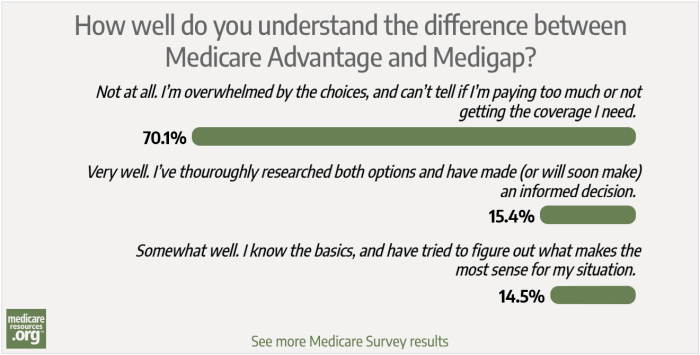Medicare enrollees have an annual opportunity to review and adjust their Medicare coverage each year, but that flexibility doesn’t apply to Medicare Supplement insurance – commonly referred to as Medigap. While Medicare Advantage and Medicare Part D have an annual open enrollment period (October 15 – December 7), federal rules only give Medicare beneficiaries one guaranteed-issue Medigap open enrollment period in their lifetime.
Medigap plans help to pay down costs that Original Medicare doesn’t cover – costs such as deductibles, copays, and coinsurance. Depending on your medical situation, you could need more or less coverage at different times in your life. Unfortunately, having only one Medigap open enrollment period does not give enrollees the flexibility to change plans if they have pre-existing medical conditions.
The truth is that you may or may not be able to change Medigap plans when you need to. That’s because although you can apply for a Medigap policy anytime, insurance companies in most states can use medical underwriting when you apply for a Medigap plan outside of the Medicare open enrollment period.
All enrollees get a single Medicare open enrollment period
Under federal rules, Medigap open enrollment starts when you’re at least 65 and have enrolled in Medicare Part B (you also need Medicare Part A in order to get Medigap, but some people delay their Part B enrollment, which is why the Medigap enrollment window begins when Part B coverage begins). This initial enrollment window lasts for six months.
(There is no federally required Medigap enrollment window for people under the age of 65 who qualify for Medicare due to a disability. But many states ensure that Medicare beneficiaries under 65 can sign up for Medigap plans. In that case, the beneficiary will also have another guaranteed-issue open enrollment window for Medigap when they turn 65, under federal rules.)
The initial enrollment period allows Medicare beneficiaries to sign up for a Medicare supplement plan without medical underwriting. Put simply, it is a time when insurance companies cannot charge you higher rates or reject your application based on your medical history. After that enrollment period ends, insurers in most states can use medical underwriting if you apply for a Medigap plan, unless you qualify for a special enrollment period with guaranteed-issue rights.
(This is based on certain qualifying life events, but the list is more limited than the qualifying life events that apply to other types of coverage. For example, moving to a new state will not trigger a Medigap special enrollment period unless you’re enrolled in a specific type of Medigap coverage called Medicare SELECT.)
To clarify, you can apply for a Medigap policy at any time as long as you have Medicare Part A and Part B. If you’re subject to underwriting — which will generally be the case in most states if you’re past your initial enrollment period and don’t qualify for a special enrollment period — the insurer will determine whether to offer you coverage, and at what price, based on your medical history. So some people will have no trouble switching Medigap plans, while others will find it expensive or impossible.
Fortunately, there are Medigap protections in place that may qualify you for a special enrollment period. Your birthday may be one of them.
Some enrollees may qualify for Medigap special enrollment
You may qualify for a special Medigap enrollment period if you have guaranteed issue rights. In these cases, insurance companies cannot charge you more based on your medical conditions, put a waiting period on your coverage, and deny you coverage.
The Centers for Medicare and Medicaid has established a list of seven situations that require insurance companies to allow you to sign up for or change a Medigap plan without medical underwriting. This list of events is somewhat limited, but you may have even more options depending on what state you live in.
As of 2026, 23 states offer Medigap guaranteed issue rights that go above and beyond what the federal government requires (this applies to annual enrollment or plan change opportunities; more than half the states go above and beyond federal requirements in terms of making guaranteed-issue Medigap plans available to beneficiaries under age 65).
A ‘birthday rule’ in 14 states allows users to switch Medigap plans
Of those 23 states, 14 have implemented a “birthday rule” that allows Medigap enrollees to switch Medigap plans without medical underwriting around the time of their birthday. (The other nine states have other windows, either year-round, or a specific time of the year, or related to the anniversary of when the person’s current policy was purchased.) To qualify for a “birthday rule” plan change, you need to be already enrolled in a Medigap plan.
- California: You have 60 days from the first day of your birth month to change to another Medigap plan with the same level or a lower level of benefits. You can also change insurance carriers during this time. This is an updated birthday rule that took effect on January 1, 2020. Prior to that the special enrollment period was only 30 days long.
- Delaware: (Effective Jan. 1, 2026) Delaware enacted legislation in 2025, ensuring that a person with Medigap can switch to another policy that offers the same or lesser benefits, on a guaranteed-issue basis. The window starts 30 days before the insured’s birthday and continues for “at least” 30 days after their birthday.
- Idaho: You have 63 days from your birthday to change to another Medigap plan with the same level or a lower level of benefits. You can also change insurance carriers. This birthday rule starts on March 1, 2022.
- Illinois: You have 45 days from your birthday to change to another Medigap plan with the same level or a lower level of benefits. This only applies to plans with your current insurance carrier pr an affiliate of your current insurer (the addition of affiliate insurers was due to legislation that Illinois enacted in 2024). To qualify for this birthday rule, you must be 65 to 75 years old. This birthday rule took effect on January 1, 2022.
- Indiana: (Effective Jan. 1, 2026) Legislation enacted in Indiana in April 2025 creates a birthday rule enrollment window, starting in Jan. 2026, that will allow Medigap enrollees to switch to any other insurer’s version of the policy they already have.
- Kentucky: Legislation enacted in 2023 allows a Medigap enrollee to switch to another insurer’s Medigap policy (same benefits as the plan they already have) within 60 days of their birthday. This birthday rule took effect on January 1, 2024.
- Louisiana: You have 63 days from the date of your birthday to select a different Medigap plan with equal or lesser benefits. This only applies to plans with your current insurance carrier (or affiliates of your current insurer, under legislation that was enacted in 2023).
- Maryland: You have 30 days from your birthday to switch to another Medigap plan with equal or lesser benefits than your current Medigap plan. This birthday rule took effect on July 1, 2023.
- Nevada: You have 60 days from the first day of your birth month to change to another Medigap plan with the same level or a lower level of benefits. You can also change insurance carriers. This birthday rule took effect on January 1, 2022.
- Oklahoma: You have 60 days from the date of your birthday to select a different Medigap plan with equal or lesser benefits, as long as you haven’t had a cover. Oklahoma’s birthday rule is considered the minimum acceptable compliance with the state’s requirement that Medigap enrollees be allowed to switch to a plan with equal or lesser benefits as long as they haven’t had a gap in coverage of more than 90 days.
- Oregon: You have 30 days from the first day of your birth month to change to another Medigap plan with the same level or a lower level of benefits. You can also change insurance carriers. This birthday rule took effect on January 1, 2013.
- Utah: Legislation enacted in Utah in 2025 gives enrollees a 60-day annual window to switch to a plan of equal or lesser benefits without medical underwriting, but only if the plan is offered by the enrollee’s current insurer. So this does not give enrollees guaranteed issue access to policies offered by a different insurance company.
- Virginia: Legislation enacted in 2025 creates a birthday rule enrollment window that allows Medigap enrollees to switch to any other insurer’s version of the policy they already have (so for example, if they have plan G, they could switch to Plan G offered by a different insurer), without medical underwriting. Virginia’s new birthday rule enrollment opportunity became available starting in July 2025. Earlier versions of the legislation would have also allowed people to downgrade to a plan with lesser benefits, but that was not part of the final legislation.
- Wyoming: Medigap enrollees can switch to any available Medigap plan that offers the same or lesser benefits, without underwriting. The window begins on the insured’s birthday and continues for 63 days.
If you live in one of these states, you may want to consider taking advantage of these birthday rules as long as you understand how they work.
Are ‘birthday rules’ likely in more states?
While Medigap is an excellent option for people on Original Medicare, some policyholders may feel that they are locked into Medigap plans with high rates. Guaranteed issue rights can help, but the situations outlined by CMS are limited to very specific situations that apply to relatively few policyholders.
The states that have created annual windows during which enrollees have at least some level of guaranteed-issue Medigap rights are helping to give Medicare beneficiaries the option to periodically review their Medigap options, even if they have pre-existing medical conditions.
The number of states offering “birthday rule” plan change windows has increased in recent years. Kentucky, Utah, Virginia, Indiana, Wyoming, and Delaware are the latest states to join this list, with plan change opportunities available starting in 2024, 2025, and 2026.
But although birthday rules have been gaining traction with state lawmakers, they can also have downsides. Requiring insurers to accept enrollees regardless of their medical history can result in higher premiums for all enrollees, and fewer insurers choosing to offer Medigap plans in the state., This is something that lawmakers and state insurance departments must take into consideration when deciding what sorts of guaranteed-issue consumer protections to put in place for Medigap plans.
Other states considering “birthday rules” in 2025:
In addition to Utah, Virginia, and Indiana, all of which have already enacted legislation in 2025 to create Medigap birthday rules, several other states are considering similar legislation or reform proposals. They include:
- Nebraska: Legislation was introduced in Nebraska in early 2025 that would create a birthday rule in the state starting in 2026. If enacted, this legislation would create a 30-day annual open enrollment period, beginning on an applicant’s birthday, during which all Medigap plans would be guaranteed-issue, without medical underwriting. Notably, the introduced version of this legislation did not specify that the person must already be enrolled in a Medigap plan. If enacted as introduced, this would ensure annual access to Medigap for anyone with Medicare Part A and Part B in Nebraska.
- Iowa: Legislation introduced in Iowa in January 2025 calls for a 30-day birthday rule starting in 2026 when Medigap enrollees would have guaranteed-issue access to any Medigap plan sold in their area with benefits equal to or lesser than their current plan.
- Michigan: Legislation introduced in Michigan in mid-2025 would create a birthday rule under which an enrollee would be allowed to switch to the same policy offered by a different insurer (it would also expand access to Medigap plans for disabled beneficiaries under the age of 65). As noted below, similar legislation was introduced in Michigan in late 2024 and did not advance.
Several states considered legislation in 2024 or 2025 to create birthday rules, but the bills did not pass:
- Michigan: Legislation (S.B.1143) would have allowed Medigap enrollees a 60-day window following their birthday, when they could switch to the same Medigap plan offered by another insurer. It would also have significantly expanded access to Medigap plans for disabled beneficiaries under the age of 65.
- Ohio: Legislation (H.B.400) would have allowed a Medigap enrollee to switch to a different insurer’s version of the same plan they already had, within 60 days of their birthday.
- South Dakota: Legislation (H.B.1108) would have allowed a Medigap enrollee to switch to a different plan with equal or lesser benefits during a 30-day window that starts on their birthday.
- Wisconsin: Legislation (S.B.412) would have allowed a Medigap enrollee to switch to a different plan with equal or lesser benefits during a 30-day window that starts on their birthday.
- Iowa: Legislation (S.F.2081) would have given any Medicare beneficiary in Iowa access to a guaranteed-issue window for Medigap plans during a 30-day window each year that begins on the person’s birthday. The text of the legislation did not restrict this to people who currently have Medigap, nor did it place any restrictions on the policy options that would be available during this window. Previous efforts to implement an annual enrollment window for Medigap in Iowa, including 2023’s H.F.228 and H.F.462, were also unsuccessful.
- Vermont: Legislation (S.230) would have created a Medigap guaranteed-issue window — running for 60 days following the beneficiary’s birthday — for beneficiaries switching from Medicare Advantage to Original Medicare. The federal government ensures guaranteed-issue access to Medigap for people in this scenario who are within their first 12 months of having Medicare Advantage coverage (trial right) but the Vermont legislation did not call for any time limit on the availability of the guaranteed-issue right it would create.
- New Mexico: Legislation considered in 2025 would have created a birthday rule open enrollment period when a Medigap enrollee age 65 or older would have had guaranteed-issue access to any Medigap plans available in the state. But the measure died in committee.
Lawmakers in those states may try again in a future year, and other states might consider this as well. Keep an eye out for more “birthday rules” in the future.
Tanya Feke, M.D. is a licensed, board-certified family physician living in New Hampshire. As a practicing primary care physician in Connecticut and an urgent care physician in New Hampshire, she saw first-hand how Medicare impacted her patients. In recent years, her career path has shifted to consultant work with a focus on utilization management and medical necessity compliance.
Dr. Feke is an expert in the field, having Medicare experience on the frontlines with patients, hospital systems, and insurers. To educate the public about ongoing issues with the program, she authored “Medicare Essentials: A Physician Insider Reveals the Fine Print.” Her analysis of Medicare issues is frequently referenced by the media, and she is a contributor to multiple online publications.








